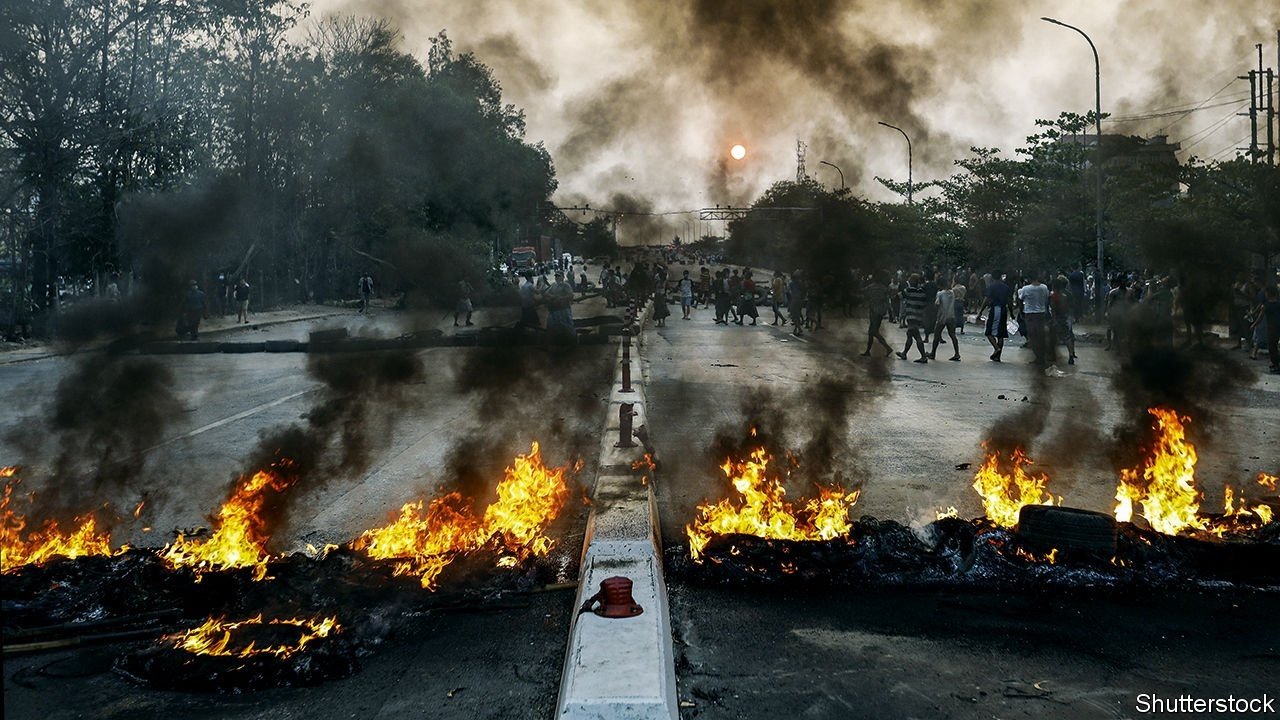WHEN THE generals who run Myanmar drew up a constitution to pave the way for an elected government, albeit one that would have no authority over the army, they termed the arrangement “discipline-flourishing democracy”. Untrammelled political competition, they suggested, would lead to disorder and impede development; only the army could ensure order and prosperity. So it is ironic that, since the army took complete control of the country again in a coup on February 1st, the only thing that has flourished is chaos.
Daily protests are a rejection of the putsch, although these have shrunk since the army began shooting unarmed demonstrators. Soldiers are rampaging through rebellious districts, beating and killing at random, and reportedly charging grieving relatives 120,000 kyat ($85) to release the bodies. Citizens have burned down shops tied to the army. A general strike has paralysed businesses. Public services have largely ceased. In the borderlands some of the 20 or so armed groups that have battled the government on-and-off for decades are taking advantage of the crisis to seize military outposts or caches of weapons. The army has bombed them, sending refugees into neighbouring countries.
In short, Myanmar is becoming a failed state. A vacuum is being created in a territory bigger than France that abuts Asia’s biggest powers, China and India. It will be filled by violence and suffering. Although Myanmar is not yet as lawless as Afghanistan, it is rapidly heading in that direction—a sobering warning of how hard it is to put a country back together. The ruin of Myanmar is not only a calamity for the 54m Burmese; it also creates risks that could ripple through the region.
Myanmar’s guerrilla-controlled enclaves produce heroin and are the world’s biggest suppliers of methamphetamine. The country also exports misery. Nine refugee camps over the border in Thailand are filled with victims of the fighting between the army and ethnically based insurgents such as the Karen National Liberation Army (KNLA). Over 700,000 Rohingyas, a Muslim minority, fled to Bangladesh from a pogrom led by the army in 2017. A newer export is disease. China last month sealed off Riuli, a border town, after three Burmese visitors tested positive for covid-19.
These problems will get worse before they get better. The army looks as if it means to hack and blast the protesters into submission. It has warned them that they risk being shot in the head and the back—as many have been. The known death toll exceeds 700. On April 9th the army gunned down more than 80 people in the provincial city of Bago. The protesters are using makeshift weapons to fight back. Some are seeking military training from the rebel militias on the borders. In a country awash with arms, that is a recipe for shedding a lot more blood.
A group of elected lawmakers who have managed to escape arrest are talking about forming a “federal army”, presumably encompassing some of the many ethnic militias. The biggest of these can muster 20,000 soldiers equipped with anti-aircraft missiles, artillery and armoured personnel-carriers. The rebels, even were they to act in concert, do not have the firepower to overthrow the army and reverse the coup. But neither has the army been able to defeat them, despite decades of trying. The KNLA has been battling the army since 1949, making its campaign the world’s longest-running civil war.
The army may eventually manage to assert its authority over the centre of the country, inhabited by the Bamar, the majority ethnic group. But the apparatus of the state will be broken. Tax collectors, teachers and doctors have walked off the job in droves. When banks reopen, they are bound to suffer runs. Foreign donors have frozen aid and foreign firms have suspended investments. Before the coup the World Bank had predicted that the economy would grow by almost 6% this year; now it expects it to shrink by 10%. Others warn of a contraction of 20%.
Neighbouring countries are alarmed. China wants to keep out covid-19 and protect strategic investments such as the pipelines that carry oil and gas from the Bay of Bengal to its interior. India has been bridling at the flow of refugees from the fighting, trying to turn them away and then reluctantly agreeing to admit them. Some members of the normally hands-off ASEAN, a club of South-East Asian countries that includes Myanmar, want to convene a summit to discuss the turmoil. Then there is meddling from afar. Russia, doubtless sensing an opportunity to needle the West, has backed the generals, sending its deputy defence minister to gladhand them.
America and Britain have imposed targeted sanctions on senior generals and the firms they control. Such measures, though welcome, will not be decisive. During earlier periods of military rule, Western pressure had little effect on previous juntas. The only outsiders able to influence the generals are Myanmar’s close neighbours: China, India and the other ASEAN countries, to whom they will turn if shunned by the West. The problem is that all these countries have stood back. Beyond airing concerns about refugees or the coronavirus, they tend to play down the havoc as an internal political affair.
Everyone’s business
That is short-sighted. Letting Myanmar slide into mayhem will cause misery to ordinary Burmese and threaten neighbours with drugs, refugees and instability. To avoid that, those neighbours should adopt a braver, more constructive approach. No country should recognise the coup; more should impose sanctions on the top brass and their rent-seeking businesses. ASEAN should suspend Myanmar’s membership. An arms embargo should be imposed (China, India and Russia are currently the biggest suppliers). Outsiders should press the army to release political prisoners, including Aung San Suu Kyi, the leader they overthrew, and start talking to her shadow government operating near the Thai border; the Thai government should turn a blind eye to the informal channels by which it gets money and supplies.
Only concerted pressure can get the generals to talk to the civilians and thereby put Myanmar onto a less ruinous path. The alternative is a failed state at the heart of Asia. ■
This article appeared in the Leaders section of the print edition under the headline “Asia’s next failed state”
Source: Economist



